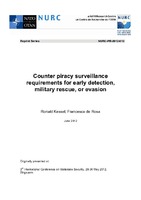| dc.contributor.author | Kessel, Ronald T. | |
| dc.contributor.author | De Rosa, Francesca | |
| dc.date.accessioned | 2018-10-11T14:09:45Z | |
| dc.date.available | 2018-10-11T14:09:45Z | |
| dc.date.issued | 2012/06 | |
| dc.identifier | 43027 | |
| dc.identifier.govdoc | NURC-PR-2012-010 | |
| dc.identifier.uri | http://hdl.handle.net/20.500.12489/674 | |
| dc.description.abstract | Best practice for protection against pirates includes coordination with the military forces operating in the area, constant watch against the approach of pirates, and measures to prevent or delay their boarding. The time won by the early detection of distant pirates and by the delay of boarding increases the chance that the military can intervene before pirates can get on board. Increased speed along an evasive course also increases the chance that pirates will break off the chase because it is taking too long or it is consuming too much fuel. Rough seas can slow pirate skiffs, adding significantly to the response time won by early detection. A probabilistic model is developed here for estimating the detection range required for escape from approaching pirates prior to boarding, either by military rescue or by evasion. The parameters in the model are taken from reports of pirate behaviour and from military coverage of the Internationally Recognized Transit Corridor (IRTC). The detection-range requirements depend strongly on the response time of military forces. For large merchant ships with maximum speeds on the order of 17 to 22 knots, the range requirements given 20-minute military response time in the IRTC are estimated to be on the order of 6.0 km. In regions outside military coverage, the ship's crew may try exhausting pirates in the chase, but it is found that the detection-range requirements given calm seas are difficult to achieve in practice. The model could be applied to faster or slower vessels and military response, and to rough sea conditions to explore a wider range of situations. The assumption is that military rescue or evasion is preferred above response by armed guards. | |
| dc.format | 12 p. : ill. (digital, PDF file) | |
| dc.language | English | |
| dc.publisher | NURC | |
| dc.source | In: 3rd International Conference on Waterside Security, 28-30 May 2012, Singapore. | |
| dc.subject | Naval piracy | |
| dc.subject | Merchant ships | |
| dc.subject | Maritime surveillance | |
| dc.subject | Target detection | |
| dc.subject | Modelling and simulation | |
| dc.subject | Evasive manoeuvres | |
| dc.title | Counter piracy surveillance requirements for early detection, military rescue, or evasion | |
| dc.type | Reprint (PR) | |
| dc.type | Papers and Articles | |
